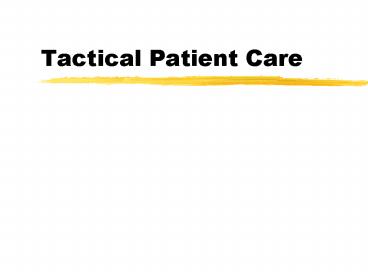Tactical Patient Care - PowerPoint PPT Presentation
1 / 20
Title:
Tactical Patient Care
Description:
One in five officers killed are shot with their own weapons ... Use of military style weapons ... and non-conventional weapons. EMT-Tactical Advanced ... – PowerPoint PPT presentation
Number of Views:69
Avg rating:3.0/5.0
Title: Tactical Patient Care
1
Tactical Patient Care
2
Body Armor
- Interwoven fibers of Kevlar
- Basically converts penetrating trauma into blunt
trauma be spreading force over wide area
3
Soft Body Armor
- Type I protects against
- .22 long rifle high velocity lead bullets with
masses of 2.6 gm (40 gr) impacting at lt1050
feet/sec - .38 special round nose lead bullets with masses
of 10.2 gm (158 gr) impacting at lt850 feet/sec
4
Soft Body Armor
- Type II-A protects against
- .357 Magnum jacketed soft point bullets with
masses of 10.2 gm (158 gr) impacting at lt1250
ft/sec - 9mm full metal jacketed bullets with masses of 8
gm (124 gr) impacting at lt1090 ft/sec
5
Soft Body Armor
- Type II protects against
- .357 Magnum jacketed soft point bullets with
masses of 10.2 gm (158 gr) impacting at lt1395
ft/sec - 9mm full metal jacketed bullets with masses of 8
gm (124 gr) impacting at lt1175 ft/sec
6
Soft Body Armor
- Type III-A protects against
- 44 Magnum lead semi-wadcutter bullets with masses
of 15.55 gm (240 gr) impacting at lt1400 ft/sec - 9mm full metal jacketed bullets with masses of
8.0 gm (124 gr) impacting at lt1400 ft/sec
7
Hard Body Armor
- Type III protects against
- 7.62 mm full metal jacketed bullets with masses
of 9.7 gm (150 gr) impacting at lt2750 ft/sec - 5.55 mm full metal jacketed bullets, .30 cal
carbine full metal jacket, and 12 gauge rifled
slugs
8
Hard Body Armor
- Type IV protects against
- .30 caliber armor-piercing bullets with masses of
10.8 gm (166 gr) impacting at lt2850 ft/sec
9
Body Armor
- Routinely worn by only 20 of police
- Type I is minimum protection recommended
- Type II-A sufficiently comfortable for full-time
wear if threat warrants it
10
Body Armor
- One in five officers killed are shot with their
own weapons - An officers body armor should handle at least
his/her own weapon
11
Body Armor
- Hits on body armor can cause
- Rib fracture
- Pneumo/hemothorax
- Pulmonary contusion
- Myocardial contusion
- Spinal cord contusions
- Penetrating wounds in spite of body armor have
high mortality
12
Body Armor
- Offers little or no protection
- When wet
- Against high velocity bullets
- Against thin or dual-edged weapons
- Produces at least a 10oF increase over the
ambient temperature
13
Body Armor
- Never do anything you wouldnt do without it
- Remember it doesnt cover the whole body
- Serious blunt trauma can still occur
- To work it must be worn
14
Tactical EMS
15
EMT-Tactical
- Developed to support law enforcement agencies in
operations involving - Prolonged commitments
- Organized opposing forces
- Use of military style weapons
- Higher risk for morbidity, mortality among public
safety personnel and citizens
16
EMT-Tactical
- Primary mission is medical support of tactical
team - Role is similar to that of a military medic
- Medical support of mission planning
- Immediate care and evacuation under fire
- Support of team members health during prolonged
operations
17
CONTOMS
- COunter Narcotics Terrorism Operational Medical
Support
18
CONTOMS
- Department of Defense (USUHS)
- Nationally standardized curriculum, certification
process, quality improvement procedure for EMTs,
paramedics, physicians who operate as part of
tactical law enforcement teams
19
EMT-Tactical Topics
- Medical preplanning
- Clandestine drug lab raids
- Emergency care in barricade situations
- Wounding effects of weapons and booby traps
- Special medical gear for tactical operations
- Personal protective gear
- Officer rescue
- Operation under extreme conditions, darkness, and
psychological stress - Special needs for extended operations
- Preventive medicine and injury control
- Medical management for chemical, biological, and
non-conventional weapons
20
EMT-Tactical Advanced
- Advanced technology applications to remote
patient assessment - Sleep/wake cycle management
- Emerging issues in chemical restraint
- Operational dermatology
- Chemical/biological exposure science
- Crisis intervention
- Management of training injuries
- Nutrition and fitness for tactical teams
- Less lethal weapons systems































